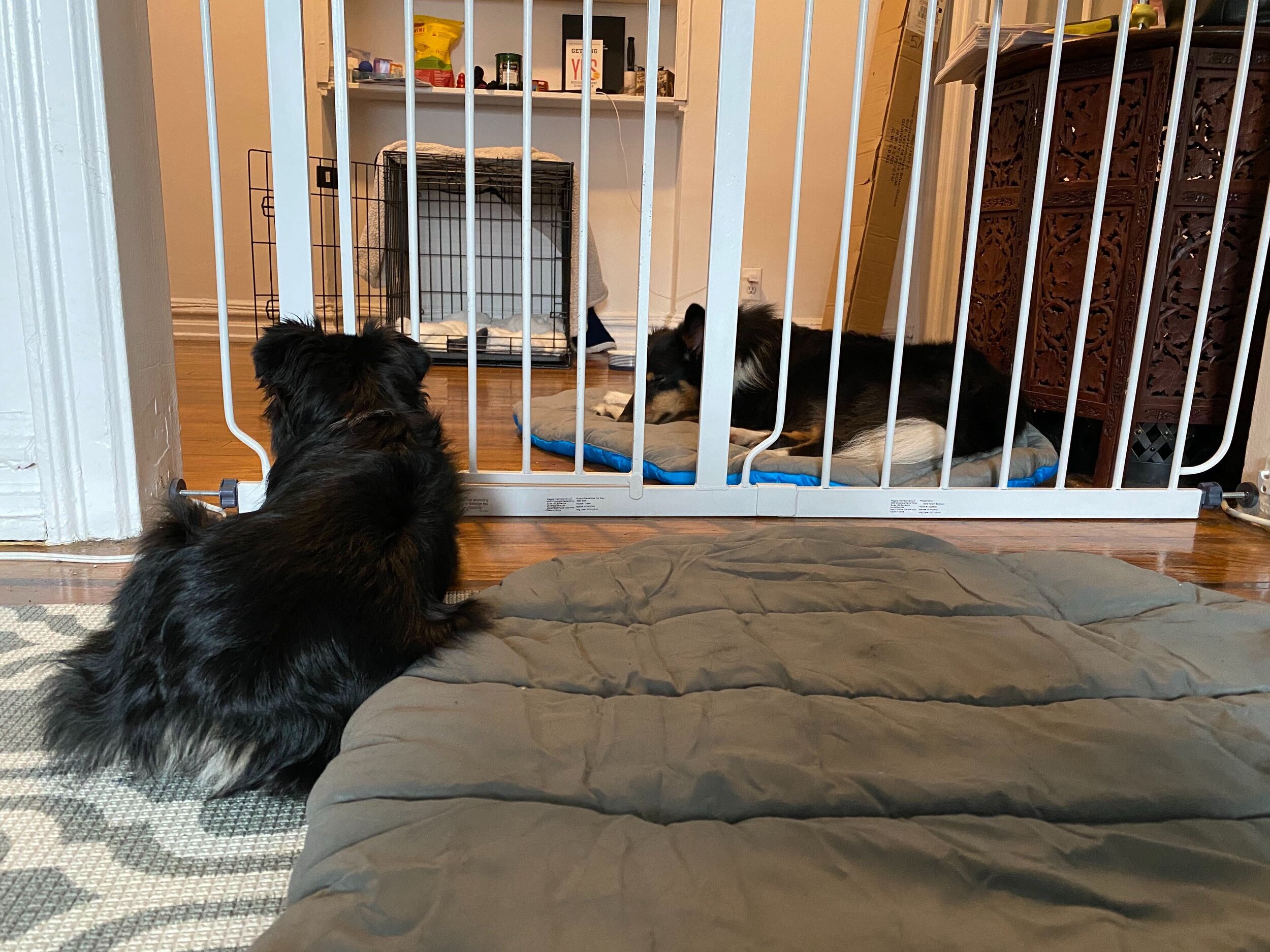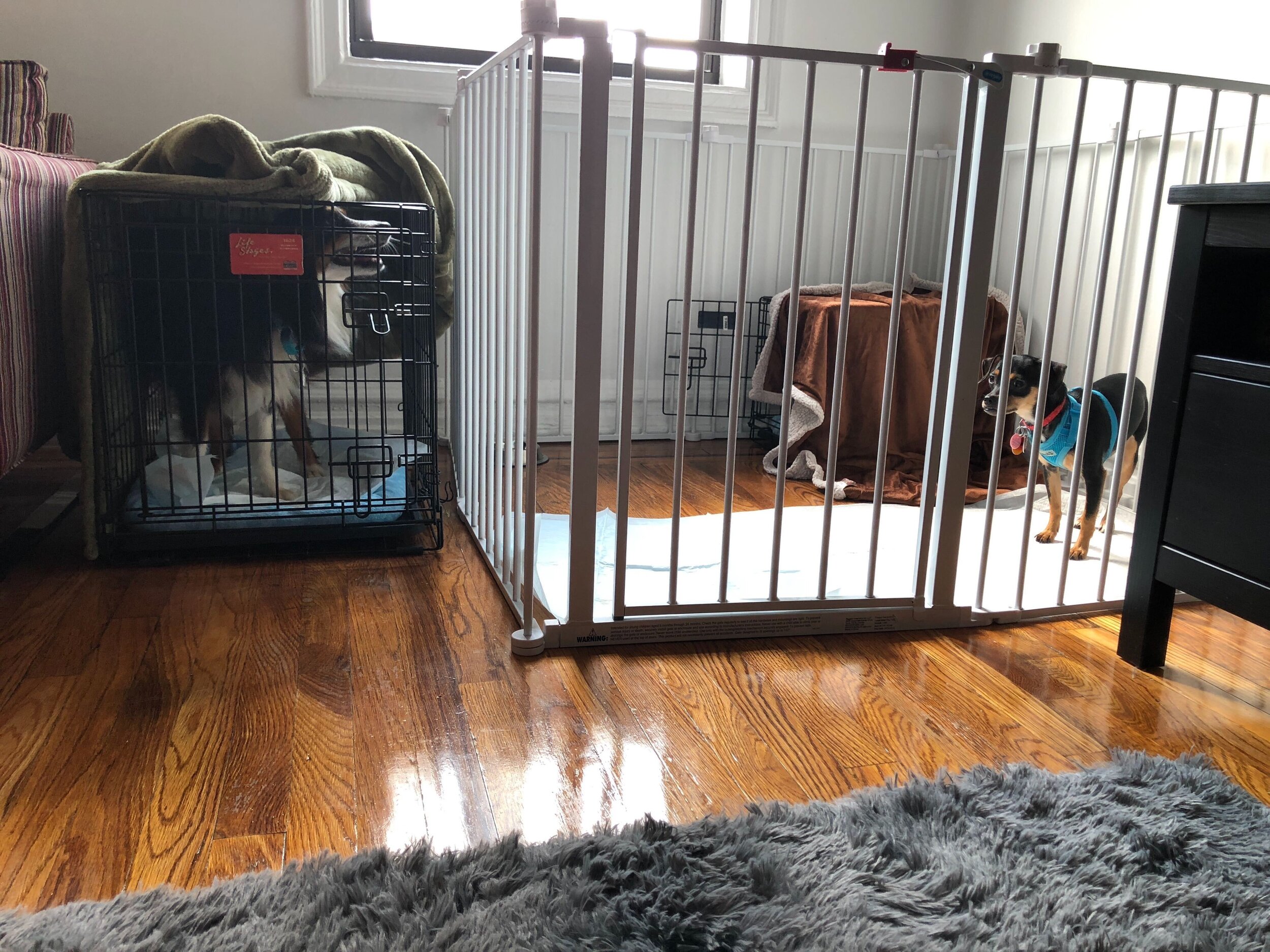⭐️ Bringing Your Foster Dog Into a Multi-Dog Household: Muddy Paws Rescue

Sandy was my fourth foster dog and my first Muddy Paws foster dog. The second she laid eyes on my resident dog Scout, all she did was bark and lunge. Scout made her so anxious and nervous that she spent the first few days barking and growling whenever she saw her in the apartment! Even parallel walks with Scout made Sandy really uncomfortable.
More than three years later, my household includes two resident dogs, and I now have a specific protocol that I follow when I bring a foster dog into my house. This allows me to slowly introduce my foster dog to my resident dogs and ensure that all three dogs can coexist peacefully.
There are several reasons why I choose to follow the separation protocol. Although I would describe both of my dogs as ‘dog-friendly’ and tolerant if properly introduced, they need time to feel comfortable and engage in play that doesn’t result in tension. They each have different personalities and do not react to foster dogs in the same way. Scout needs about a week or so before she begins playing with our foster dogs, and she really does not like when a foster dog initiates play or gets too close to her before she is ready. On the other hand, my second resident dog Brewski is eager to play within a day or two! He is however more likely to overreact and snap if allowed to play with the foster dog before he feels comfortable. Most importantly, I don’t want to overwhelm my foster dog in a new environment.

To date, I have fostered over 30 dogs, with the majority of them being adults over two years old. I am by no means an expert on dog-to-dog introductions, but I know my dogs—and based on my experience, slow introductions and allowing a foster dog to decompress before permitting interactions with resident dogs are integral components of a successful relationship between foster fur siblings!
I always separate my dogs from the foster dog for at least 24-48 hours. I don’t let them sniff each other right away, even through the baby gate. I want them to get used to each others’ scents without being too close, thereby making each other uncomfortable. I make sure that the foster dog has the option to go into their crate or their own area where they can relax without being seen by, or seeing, my dogs. I used to always start with parallel walks on a neutral territory when I only had one dog because Scout is not leash reactive and ignores dogs when on a leash, even those that bark at her. However, with the arrival of Brewski—a leash-reactive dog “in recovery”—I find that parallel walks go much smoother after all three dogs have had a chance to get acclimated to each others’ presence (from a safe distance). My dogs are used to having new dogs enter our apartment on a pretty regular basis, and they do not react to another dog’s presence when they are safely separated from them and are not forced to interact.
After the foster dog has had a chance to decompress (usually overnight), I allow minimal interaction in the form of parallel walks. By that time, my dogs are completely ignoring the foster dog and are fine walking closely to them. My rule of thumb: I do not allow the dogs to be in the same area where they are not separated by gates or other barriers until and unless the dogs can calmly co-exist when separated and exhibit body language that indicates that they are comfortable, relaxed, and not bothered by each other’s presence (napping, ignoring each other, and not obsessively tracking each other’s whereabouts). I am a firm believer that slow introductions over several days (sometimes even as long as a week or two) lead to a better, safer, and more peaceful cohabitation.

Some of my foster dogs have been nervous and scared chihuahuas who like their space and don’t enjoy when dogs bigger than them approach them before they are comfortable. Maggie was a jumpy chihuahua mix who after a few days loved playing with my boyfriend and I, but never warmed up to my dogs. However, because we separated her from my dog and only allowed limited interactions through baby gates for the first four days, by the time we removed the physical barriers, my dogs were not really interested in her and mostly ignored her—which suited Maggie just fine!
Once the dogs are comfortable in each other’s presence and they’ve interacted in positive ways through the gate (sniffing each other, wagging tails, exhibiting soft body language), I let them hang out together in one room without physical barriers—although I do keep the leash on the foster dog for at least the first week whenever they are interacting with my dogs (it doesn’t have to be held constantly; I let the leash drag behind them). There are no toys, food, or water in the same room during the first week; the dogs are fed separately, and when I first start dispensing treats to all three dogs, I always do it from separate hands while not allowing the dogs to crowd me.
If a play session starts, I keep it short and break it up if I start seeing tense body language or if I hear growling. The more positive interactions my dogs and the foster dog have (and the fewer negative interactions they have), the better their relationship will be!
One of my most recent foster dogs, Ozzy, gets along splendidly with both of my dogs. However, when he first met them (specifically Brewski), he was not a fan. He barked loudly whenever he saw Brewski, and our first parallel walk the next day wasn’t a great success. But after few days of very limited interactions through the baby gate, Ozzy’s body language assured me that he felt comfortable with my dogs, and he was no longer a novelty and a stranger to them. His presence did not excite Brewski and did not make Scout uncomfortable. As they grew more and more comfortable with each other—and as I learned that Ozzy did not guard toys—I slowly introduced toys into the mix. This led to plenty of positive playful interactions, tug-of-war played several times a day, and toys shared without any conflict (but always supervised!).
Slow dog introductions not only help the foster dogs who stay with me feel comfortable, but they also turn fostering into a positive experience for my own dogs.
In addition, check out this extremely helpful article to refer to when learning how to properly introduce two dogs to each other.
Happy fostering!
Kathy is a foster, volunteer, and member of the Muddy Paws Foster Team.
